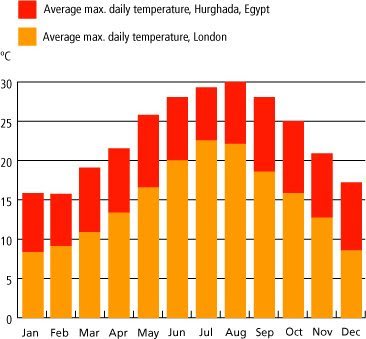The climate in Egypt is most temperate; the sun practically I shines the year round, at least eight hours a day, and rainy days are the exception. Even in the summer months (June-August), the northern wind blowing from Europe brings about a milder weather. Although the desert regions of the country have a continental climate, the Nile-valley keeps a temperate climate throughout the year.
Generally Egypt essentially has a hot desert climate (Köppen climate classification BWh). The climate is generally extremely dry all over the country except on the northern Mediterranean coast which receives rainfall in winter.
Ancient writings indicate that, as far back as Pharaonic times, a large number of Egyptian cities enjoyed a healthy climate, with curative properties. The ancient Greek scientists who fathered the science of therapeutics have emphasized in their writings the importance of Egypt in that domain, and advised people to benefit from the climate and sun of Egyptian cities.
Herodotus states that the good health of the Egyptians and their strong constitution is due to the ever shining sun of Egypt, and the wholesome climate of its cities.
Egypt is known for its mineral springs, such as those of Helwan, the most important town for therapeutic tourism. The relevant authorities in the country have established physiotherapy sections in hospitals, and focused attention on physio therapeutic centers, such as Helwan, Ein Esseera, El-Goushbi, Fayoum, Mersa Matrouh, the shores of the Red Sea, Aswan and many others.
Egypt has a large number of modern specialized hospitals. equipped with sophisticated medical appliances.

